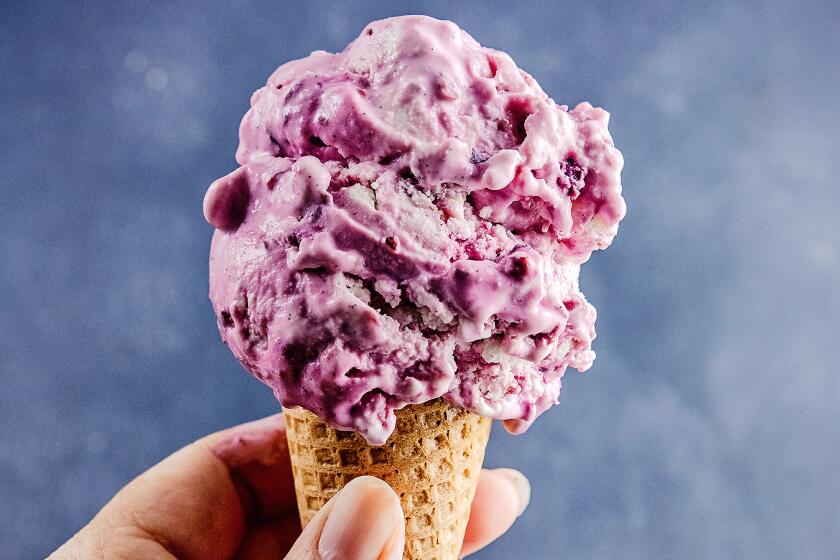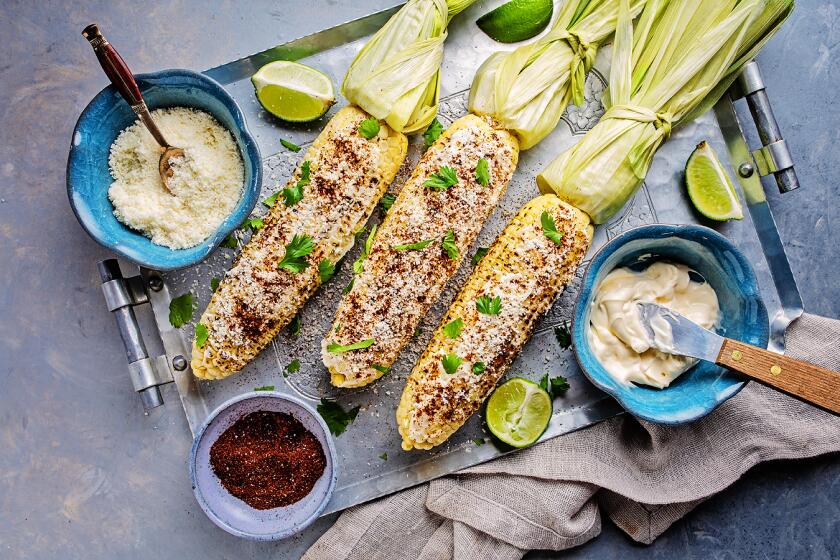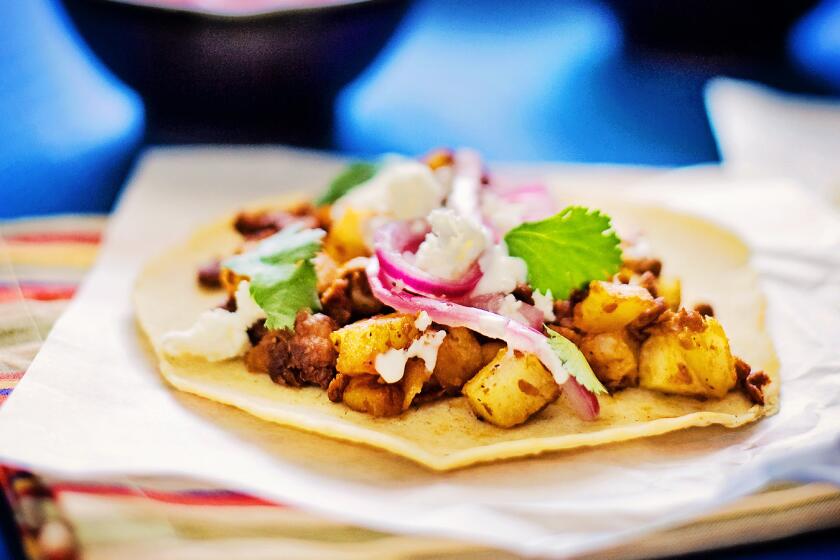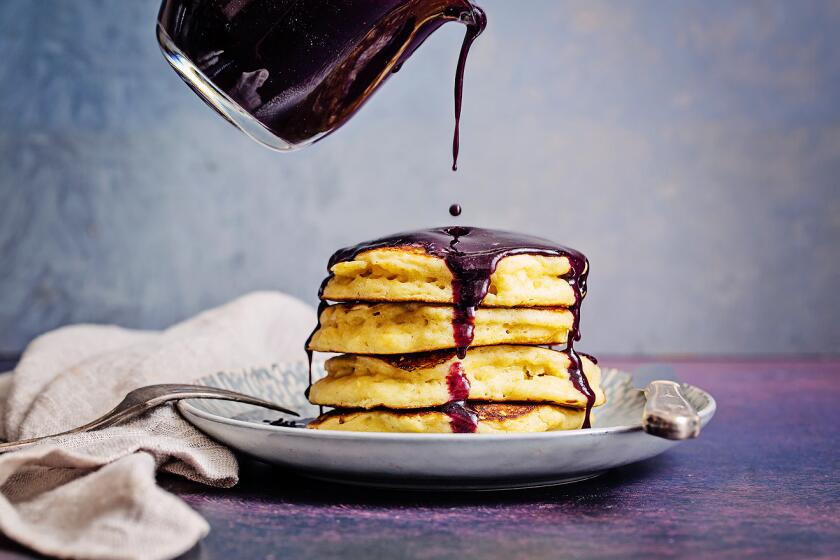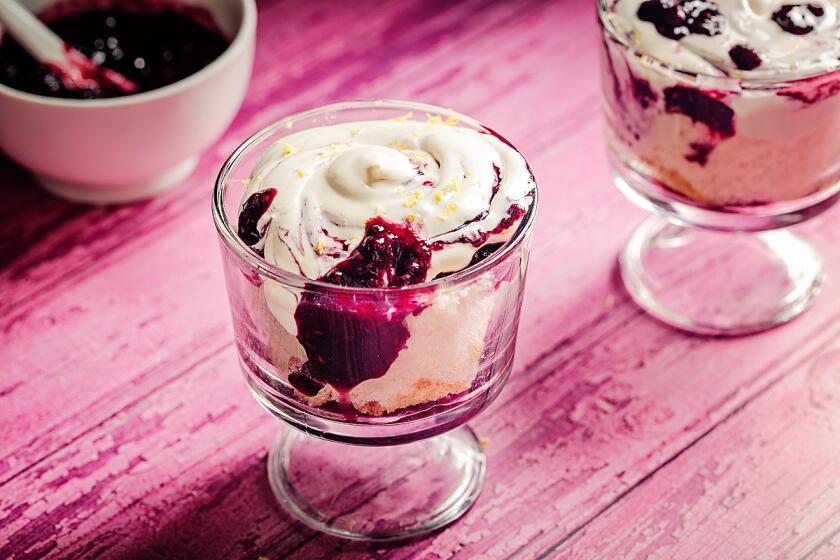Banana leaves transform texture of chicken tamales
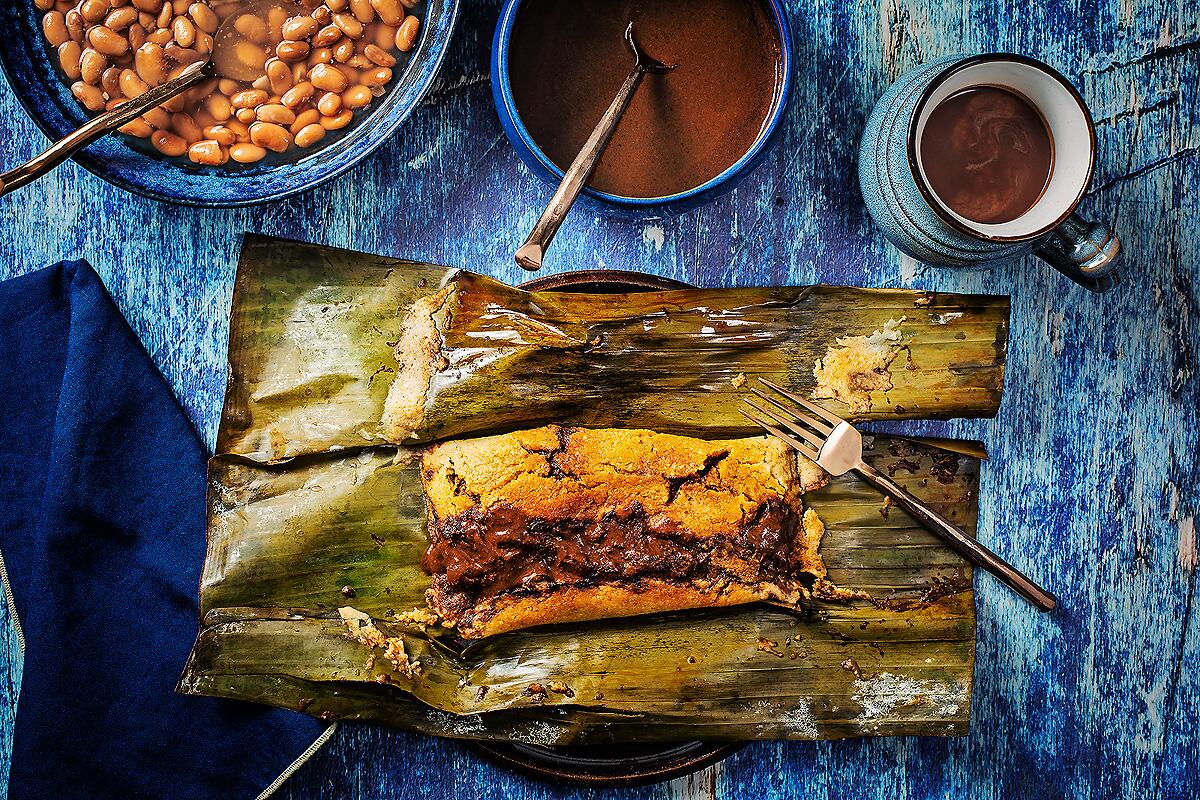
Leaf wrapper, instead of corn husk, helps keep in moisture and concentrate flavor; using prepared mole drastically reduces prep time
I often crave tamales. When that craving hits, I’ll make a dozen or two, enough for dinner and lunch for my auntie and me, plus some to toss into the freezer for those midweek meals when we want something warm and hearty with little fuss.
I shared my version of homemade mole negro last year, but if you found it intimidating and didn’t make it, I have a convenient shortcut for you.
Doña Maria was the mole of my childhood. The 65-year-old Mexican brand makes mole paste sold in jars and available at most major supermarkets. This paste is not a finished sauce, but a base with chiles and spices found in a traditional Mexican mole. The directions on the jar are basic: Mix 1 part paste with 2 parts broth, creating a serviceable sauce. However, my mother always doctored it with fresh ingredients, like homemade chicken broth, peanut butter and some Ibarra chocolate. She’d make it at least once a month, poaching chicken directly in the sauce until it was “fall off the bone” tender.
Opening those pesky jars!
Most Mexican families collect the glass jars these moles come in. We used them as glasses for water and juice and to keep our garden-picked cilantro fresh in the refrigerator. They’re lovely. But because they’re usable drinking glasses, the lids don’t screw on and can be difficult to pop off mess-free.
Doña Maria knows how much people struggle with these lids and has attempted to make them easier to open. The newer tops now have a three-point pattern that tells you where to apply the pressure to open them. The picture shows a bottle opener; you’re supposed to use it to pry open the lid at each point. But not all bottle openers are created equal. The magnetic one that hangs out on our refrigerator is the kind that punctures a can on one end and opens a bottle with the other. Unfortunately, it doesn’t have a long enough tooth to grasp onto the underside of the lid, rendering it useless as a Doña Maria jar opener.
If you’re in the same boat, there’s another way to open these jars: a knife blade.
Don’t freak out: It isn’t a scary, “might wind up in the ER” affair. Just follow me here:
- Using a Sharpie, mark the jar lid’s side at each of the three points on the top.
- Fold a paper towel in half, place it on the counter, and turn the jar upside down onto the towel.
- Pry a steak knife between the lid and the jar at the three points you marked, wiggling the blade to pry the lid slightly away from the glass. Once you pry the third point, you’ll hear a slight pop as the air escapes from the jar. Quickly flip the jar upright, using the towel to hold the lid.
- You can now easily pull the lid off. Be slow and methodical here, though, because that oil is to the rim and will spill everywhere if you jerk the jar slightly.
And by the way, writing these instructions took much longer than it will take you to open the jar this way, trust me.
It’s open. Now what?
Doña Maria mole is a paste, and while it sits on the store shelves, the chile oil separates from the solids. People unfamiliar with using mole paste assume this indicates spoilage. It doesn’t. It’s perfectly normal (think natural peanut butter and its oil separation). Pour the oil into a blender. Use a butter knife to run along the jar’s glass wall, prying the thick, dry paste free and dumping that into the blender. Add some canned fire-roasted tomatoes, onion, garlic, chicken broth, and nut or seed butter (chocolate is optional), blending until smooth. If using this mole for tamales, transfer the mixture to a bowl.
If, however, you want to serve this mole over chicken and call it dinner:
- Heat a tablespoon of oil in a deep, 5-quart soup pot.
- Once the oil is shimmering, pour in the mole.
- Add ½ cup of broth to the blender jar, swirling to loosen up any mole left behind, and add that to the pot.
- Simmer for 5 minutes. Add 8 cooked chicken pieces to the pot (I love freshly poached thighs and legs, but you could also break down a whole rotisserie chicken into 8 pieces).
- Turn the chicken to coat well.
- Simmer on low until heated thoroughly.
- Serve over rice.
Banana leaves set these tamales apart
I wrapped these tamales in banana leaves, a typical wrapper in the southern states of Mexico. The main difference between banana-wrapped tamales and those in corn husks is texture: Tamales are moister when steamed in the less-porous banana leaves, and the flavors are more concentrated than the same mole-flavored tamales steamed in cornhusks.
Packages of whole fresh banana leaves are available in many Latin and Asian markets. I buy mine at Northgate Market, but you might also find them at grocery stores in areas with a large Latino population (I’ve seen them at Ralphs and Food4Less).

Banana leaves are stiff and need preparation to make them usable as wrappers. I trim off the tapered top, as its pointed shape makes it challenging to use as a wrapper (save these; you’ll use them to line the steamer pot). Then I cut them down into 6- to 8-inch segments (I typically can get 4 to 6 pieces from each leaf). Next, I use scissors to cut away the thick vein that remains on the inner side. Finally, I turn the stove on and pass the leaf over the grates. As it heats up, the leaf will change from dull green to bright green and become shiny. I keep the leaf moving as an area changes so the entire surface is warmed and transformed. This simple technique makes the leaves pliable and easy to wrap around the filling.
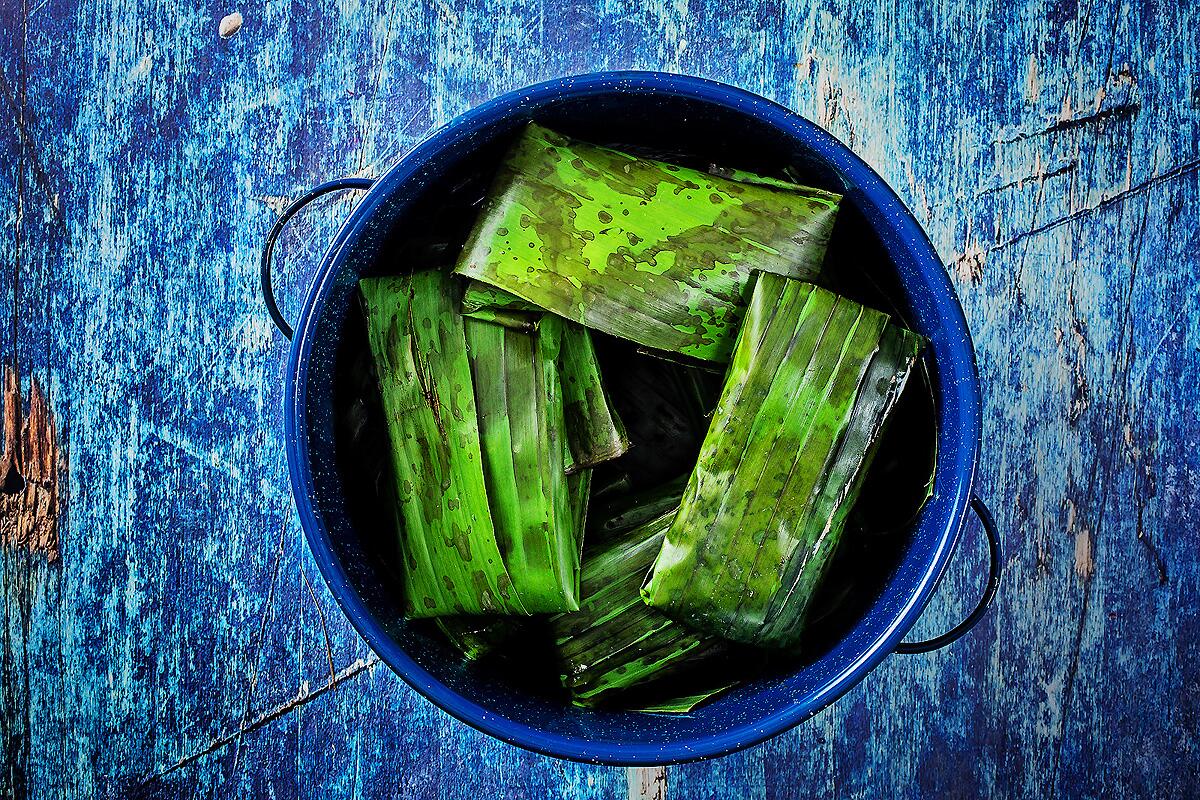
Tamales de Pollo con Mole en Hojas de Platano
Maseca makes a masa harina labeled Tamal Instant Corn Masa Flour. It’s a coarser grind than masa harina typically used for tortillas, and it’s widely available. However, if you have time to order masa harina, I suggest buying it from Masienda.com. They only sell one fine grind, but the corn is organic single-origin heirloom maize from farmers in Mexico dedicated to keeping the old traditions alive. The flavor is superior to all other brands I’ve used over the years. I like to use their white corn masa harina for tamales. Please skip the social media trend of shredding the chicken with a mixer, which creates uniform mush. Instead, hand shred, varying the widths and lengths of the pieces to create a more pleasing, chunky texture.
Makes about a dozen
1 package fresh banana leaves
FOR THE MASA:
4 cups masa harina
1 tablespoon baking powder
1 tablespoon kosher salt
3 cups warm chicken stock
1½ cups room-temperature lard (preferable) or vegetable shortening
FOR THE MOLE:
1 (8.25-ounce) jar of Doña Maria red mole
½ cup canned fire-roasted tomatoes
¼ white onion
1 fat clove garlic
¼ cup peanut butter, almond butter or tahini
2 cups warmed chicken stock
TO ASSEMBLE:
4 cups cooked chicken, hand shredded
Special equipment: Tamale pot with a steamer insert or an 8- to 10-quart pot with a deep steamer basket
Prepare the leaves: Cut off the tapered end (about 4 inches). Divide each leaf into 4 to 6 equal segments depending on how big the leaf is (you want approximately 6- to 8-inch segments). Trim off the hard stem. Turn on the stove and pass a leaf segment over the grates, continuously moving it around as it changes color from the heat. When the entire segment has changed color, remove it and repeat with the rest. Set the leaves aside.
Make the masa: Whisk the masa harina, baking powder and salt until well combined. Add the stock, hand mixing and kneading until a ball forms. Cover with a damp cloth. Add the lard to the bowl of a stand mixer. Using the whisk attachment, whip the lard on medium-high until it’s light and fluffy, about 15 minutes. Change to the paddle attachment. Add a quarter of the masa and mix, starting on low and working your way up to medium speed. Once it’s thoroughly combined, add the next quarter. Continue, beating well after each addition. Once you’ve combined all the masa with the lard, continue to beat on medium speed for 10 minutes. Place a damp cloth over the bowl; set it aside.
Prepare the filling: Add all the ingredients for the mole to a blender and puree until smooth. Reserve 1 cup of mole and set aside. Pour the rest into a bowl and add the shredded chicken, mixing well.
Assemble the tamales: Lay a leaf segment on your work surface with the lines running horizontally. Spread 2 generous tablespoons of masa in the center in a 5- to 6-inch square and about ⅛ inch thick. Drizzle some of the reserved mole over the masa. Add 2 generous tablespoons of the chicken to the center. Pull the top of the leaf over the center toward you. Take the long edge closest to you and fold it back over the center. Gently massage the filling toward the center on both ends, fold one end over toward the center, and then repeat with the other end, creating a tight package. Remove to a tray, seam side down. Repeat until you run out of leaves or masa.
Steam the tamales: Fill the pot with water up to just below the steam plate of a tamale pot or the steam basket of a standard steamer pot. Drop two or three clean pennies into the pot before inserting the steam plate or basket. Use one of the tapered leaf segments to line the bottom of the steamer. To allow steam and liquid to pass through, use a paring knife to poke eight random holes into the leaf. Place the first layer of tamales on the bottom in a circle, following the contours of the pot, leaving the center open. Continue to layer the tamales on top of each other, leaving the center open (this allows the steam to move freely, cooking the tamales at the top). Cover with any leftover leaves, then top with the lid. Turn on the heat to medium-low and steam tamales for 1½ hours.
If you hear the pennies rattle, you’re low on water. Remove the lid and the top leaves. Using a pair of long tongs, reach down to the bottom leaf and gently pry a side away from the wall of the pot to clear a path for adding more water. Slowly pour a cup of hot water down the wall, lay the bottom leaf flat again, re-cover and continue steaming. After 1½ hours, remove one tamal. Let it rest for 10 minutes. Carefully open; the tamales are ready if the masa pulls gently away from the leaf and looks moist but not wet and raw. If it seems overly damp or even still raw, refold the leaf and return to the pot, cooking for 20 to 30 minutes longer.
Serve tamales drizzled with the reserved warmed mole and a side of beans. Mexican hot chocolate is a traditional accompaniment.
Store completely cooled tamales in the refrigerator for up to a week or freeze them for up to a year.
Recipe is copyrighted by Anita L. Arambula and is reprinted with permission from “Confessions of a Foodie.”
Arambula is the food section art director and designer. She blogs at confessionsofafoodie.me, where the original version of this article was published. Follow her on Instagram: @afotogirl. She can be reached at anita.arambula@sduniontribune.com.


